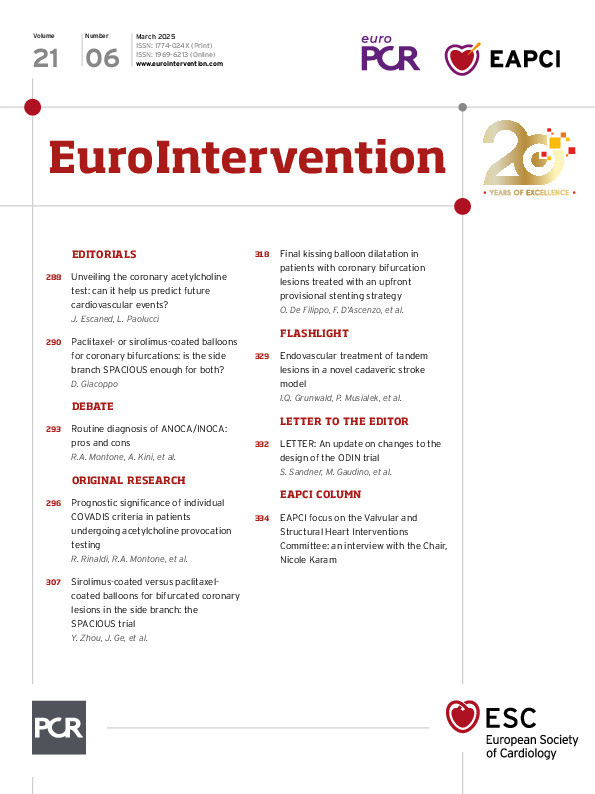Cory:
Unlock Your AI Assistant Now!
In 2025, we have good reasons to consider acetylcholine (ACh) testing a part of the standard coronary diagnostic toolkit of our catheterisation laboratories. As shown by the AID-ANGIO study, vasomotor disorders are highly prevalent in patients with chronic coronary syndromes referred for coronary angiography1. Since vasomotor derangements cannot be reliably diagnosed with non-invasive methods, ACh testing performed at the time of diagnostic angiography can be decisive in reaching a diagnosis in patients who, otherwise, may stay trapped in a never-ending loop of unsuccessful tests2. Once a diagnosis is made, patient symptoms may be successfully addressed using drugs like calcium channel blockers and nitrates. All this justifies why clinical practice guidelines recommend its use as part of functional testing for ischaemia with non-obstructive coronary arteries (INOCA)2.
In interpreting patients’ responses to ACh, the most widely used approach is that recommended by the Coronary Vasomotor Disorders International Study Group (COVADIS)3, which uses three different criteria for test positivity: (1) development of chest pain with anginal characteristics, (2) ischaemic electrocardiogram (ECG) changes, and (3) epicardial spasm ≥90% during the test. Meeting these three criteria defines “epicardial spasm”, while the combination of criteria 1 and 2 define “microvascular spasm”. Positive COVADIS criteria have been associated with an increased risk of adverse events during follow-up4. A pending, unanswered question was whether the positivity of individual components of the COVADIS criteria could convey prognostic information.
In this issue of EuroIntervention, Rinaldi and colleagues provide new evidence addressing this question5. In their research, the authors included, over a 7-year period, a total of 519 patients with non-obstructed coronary arteries in whom intracoronary ACh testing was performed to rule out vasomotor disorders causing INOCA or myocardial infarction (MINOCA). Contrary to standard practice, the authors did not perform a full INOCA screening including also coronary flow reserve (CFR) and microvascular resistance measurements. According to ACh test responses, patients were stratified using individual COVADIS criteria. At follow-up (median close to 2 years), a comparison between groups was performed regarding the occurrence of the composite endpoint of major adverse cardiovascular and cerebrovascular events (MACCE) encompassing cardiovascular death, non-fatal myocardial infarction (MI), hospitalisation due to unstable angina (UA) and stroke/transient ischaemic attack. Patients without positive COVADIS criteria had significantly lower rates of MACCE (3.1%) compared to those who showed 1 (9.2%), 2 (10.3%) and all 3 (15.4%) positive criteria. Moreover, the occurrence of an epicardial spasm causing ≥90% diameter obstruction was an independent predictor of MACCE regardless of clinical presentation (MINOCA or INOCA) or signs of ischaemia during ACh testing (e.g., symptoms and ECG anomalies). Thus, the research suggests that ACh testing may provide prognostic information related to specific cardiovascular disease phenotypes. Of note, the increase in MACCE within study categories was driven by hospitalisation due to unstable angina, and not by hard endpoints like myocardial infarction or death.
Some considerations on prognostication in patients like those included in this study should be made. While there is overwhelming evidence on the predictive value of abnormal CFR for hard endpoints like mortality6, evidence for vasomotor disorders is modest47. Yet, there is a possibility that the approach used to assess vascular responses to ACh testing indeed matters in performing risk stratification. A recent study has shown that when the response to ACh infusion is measured in terms of increase in coronary blood flow, both CFR and ACh response are predictors of major adverse cardiac and cerebrovascular events8. Whether the use of COVADIS criteria proposed in this study is comparable to ACh testing with quantitative flow measurements in terms of prognostication remains to be explored.
Regarding stratified treatment for angina according to ACh test results, the authors observed differences in the Seattle Angina Questionnaire (SAQ) score at 12-month follow-up, with poorer anginal control when the 3 COVADIS criteria were present (SAQ score 82), compared with patients with no COVADIS criteria (SAQ score 88). One of the obstacles in interpreting these findings is that baseline SAQ scores were not collected, and therefore the net gain in symptom control remains unknown. Besides, performing an analysis of anginal symptom improvement in a mixed population of patients with INOCA (investigated because of having chest pain) and MINOCA (investigated because of having a myocardial infarction) is confusing.
Overall, the research by Rinaldi et al5 has the merit to focus on risk stratification of patients undergoing coronary ACh testing, generating new research topics that need to be explored in future studies.
Conflict of interest statement
The authors have no conflicts of interest pertaining to this editorial to declare.

